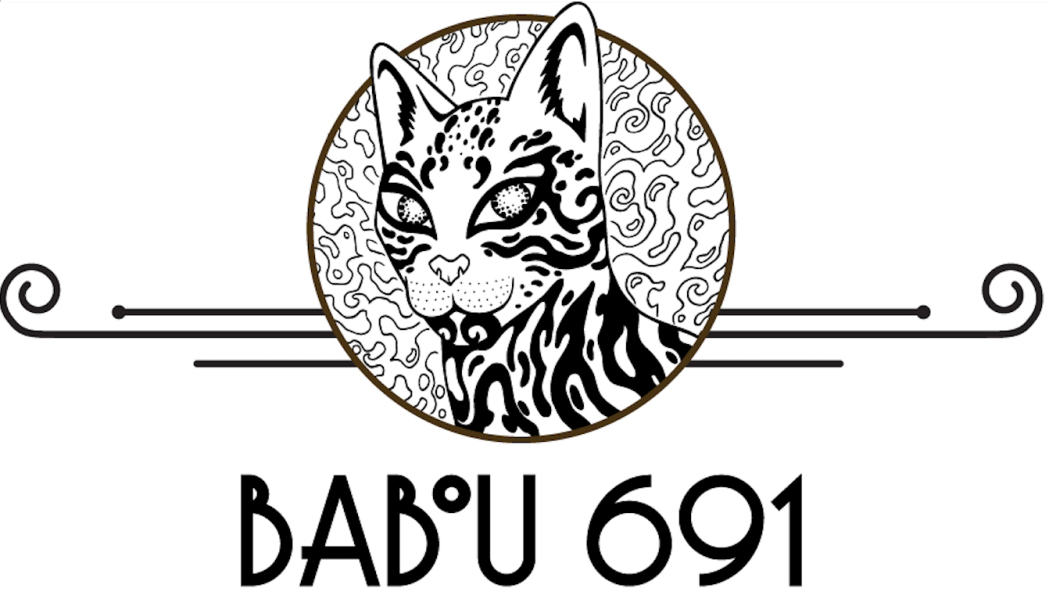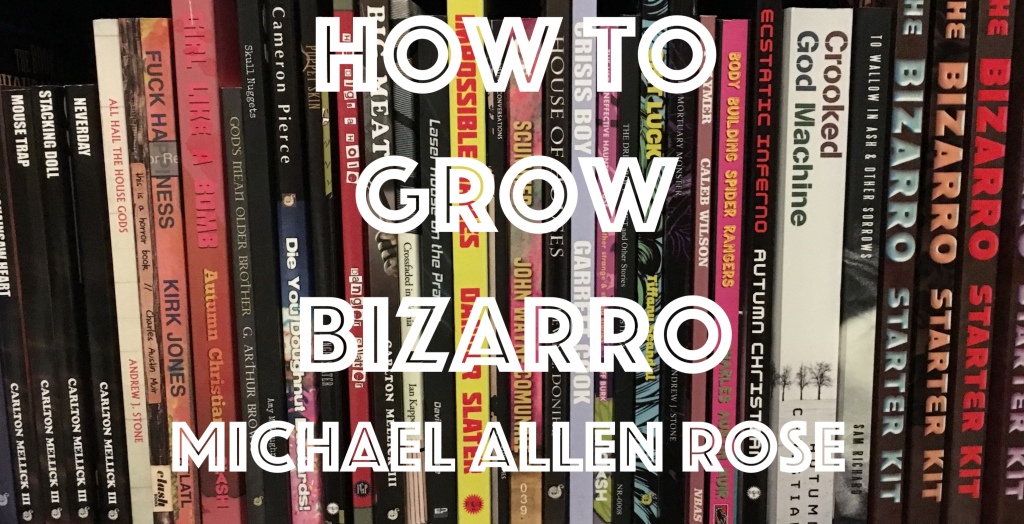Welcome to Part 4 of 6 in our series “How to Grow Bizarro 3.” This series began on the Zé Burns Blog back in December of 2019. How to Grow Bizarro 1 covered ways the average reader could help strengthen and expand the genre, while How to Grow Bizarro 2 looked at the larger picture. This current series asks members of the bizarro community THEIR thoughts. This week: the multi-talented Michael Allen Rose
By Michael Allen Rose
Since the beginning of the bizarro genre, participants have been asking how they can grow it, make it stronger, and reach more potential fans. Through its ups and downs, those involved have tried and considered any number of approaches, some of which have been successful, and some, at best, learning experiences. As someone who entered the bizarro scene around the second wave, in the late 2000s, I find my perspective has shifted with the community, but my ideals remain the same: the importance of community, mutual support, and the idea that a rising tide raises all ships. This is, by no means, a definitive encyclopedia of the bizarro scene and what’s happened to it, but maybe some comparison and historical perspective can help us find the magic of what is possible in bizarro and pluck from its past those things that will lead it to a brighter future.
The early to mid 2010s felt like a golden age for the burgeoning bizarro scene. Eraserhead Press was pumping out a ton of material, including the New Bizarro Author Series and many books from its imprints Lazy Fascist, Deadite and Fungasm. At that time, there were even a few other imprints, including Spunk Goblin (bizarro for kids) and a science-fiction leaning imprint called Fantastic Planet. Rooster Republic and Bizarro Pulp Press had appeared on the scene; Atlatl, Copeland Valley, Grindhouse, Raw Dog Screaming Press and others were putting out bizarro books alongside their other contributions to genre fiction. People from the horror and indie lit scenes were finding their way to the bizarro shores and many self-publishing authors were joining the movement. Every year, the vast majority of people who considered themselves “bizarro authors” made a pilgrimage to Portland for Bizarro Con, including even people who later distanced themselves from the genre.
Then, toward the end of the decade, something began to happen. I remember sitting in a hot tub at Bizarro Con with horror grandmaster Brian Keene, talking about my fledgeling career, the bizarro genre, comic books, and other profession-related topics, when he said (and I paraphrase), “I remember when horror was where you guys are now. Bizarro is getting bigger. This is when you’re going to start seeing the cracks, where people splinter off and do their own thing.”
He was painfully right. Within just a few years, what had once been very much a monoculture became splintered and fragmented in ways that were new to the community. Suddenly, there were people forming online cliques that had their own definitions of bizarro to work by. There were people who disavowed the genre, or the community. Authors who didn’t get what they expected from the community and struck out on their own. Feuds and disagreements and perceived slights. These, as Keene pointed out, are necessary growing pains, but that doesn’t make them easy to deal with. Much like punk rock before it, as the underground movement gained momentum and got bigger, it diversified and branched, and not everyone got along.
It’s important to note that this shouldn’t make you feel hopeless—quite the contrary—this illustrates the central tenet that brought everyone together: we were all outcasts, artists whose art didn’t fit neatly into other people’s boxes. A scene of misfits and weirdos that found each other and made a tribe. I can’t begin to describe how magical that feeling was, and it was almost universally parroted by everyone who attended Bizarro Con: I found my people. The first thing I think bizarro needs to grow into a successful future is for people to rebuild that support, that sense of togetherness, and that idea that a rising tide really does raise all ships. The people I’ve met in the genre have become some of my closest friends, and over time, even those people who didn’t necessarily see eye-to-eye with me found people in the community who they did fit with, like puzzle pieces. It didn’t matter that we had little in common in certain areas, because in that one that mattered, we were in sync. We were making weird fiction, and we were going to help each other. To grow. To learn. To write better books. To make art happen.
What tangible things can be done to bring the bizarro scene back together? There are tons, many of which some of us regularly practice. When you’re booking an event or a performance, think about your friends in the bizarro scene that might be a good fit. Put together zines and talk about books and authors you like. Collaborate with other people who make things. This is something I’ve been working toward a lot for the past few years: a book with Danger Slater, a comic with Andrew Goldfarb, an art book with Erik Wilson, music and more with John Wayne Comunale, or when Christine Morgan or Andy De Fonseca contribute to my Patreon chapbooks. It’s fun to make things with your friends, but moreso, every time I release something with multiple bizarros attached, their audience sees my work, and my audience sees their work.
Rose O’Keefe said it best (and again, I paraphrase) “Talk about other people’s books.” People get tired of endless self-promotion, but you know what people love? Tell them what’s cool. Tell people about your friends who make amazing things. Review books. Don’t just stick to the people you know—seek out new authors and artists. Ask them who they read and love. Your voice matters, and for many of us, it’s about the only reliable way to get the word out that we exist. Small presses and indie authors have very little (if any) promotional or marketing budget—we are our own best hope for one another.
We have a space ready for a consortium of publishers and press releases: the redesigned Bizarro Central website. Editor-in-chief David Barbee, flash fiction editor Eric Hendrixson, and web designer Sauda Namir would love for interested parties to submit content such as reviews, short fiction, news, art, or whatever makes sense in the context of bizarro fiction. We have the Bizarro Writers Association, mostly in Portland, but the Chicago branch thrived when more authors were in the area, and the British bizarros have their own network as well. For a time, we curated a Google Map that had pinpoints all over the globe. It told us where our colleagues lived, so when booking tours, or doing conventions, we’d have people and resources. I see so many folks asking for these beautiful ideas to blossom, and the wonderful thing is, we have the infrastructure for them already. What we need is the enthusiasm, the openness, and the bravery it takes to open up and care about other people.
It’s hard, especially because, traditionally, making art with your words is a solitary process. But, it’s possible. I’ve seen it. Reach out. Say “hi” to bizarro authors, publishers, editors. Share their content. Tell friends about books you like. Plan a little anthology and invite people to do something with it. Remix a song. Paint a picture. Write bios of your favorite writers and pair each one with the fruit you think they’d be. Bizarro works best when it’s an interconnected web of insane content, pumped out by friendly, prolific, daring artists. It is what we want it to be—we define it as a community. The reality is: there are no gatekeepers. We’re all in this together, constantly defining and redefining our community of weirdos and outsiders, and if we act like that’s true, we can find some gold again.

Michael Allen Rose is a writer, musician, editor and performance artist based in Chicago, Illinois. His stories have been published in such periodicals and anthologies as the Magazine of Bizarro Fiction, Heavy Feather Review, and Tales From The Crust. He has published several books including Embry: Hard Boiled (Eraserhead Press), Rock And Roll Death Patrol (Rooster Republic Press), The Indifference Of Heaven (Omnium Gatherum) and more. In Spring of 2021, Perpetual Motion Machine Publishing will release Michael’s newest book, Jurassichrist. He is the host of the annual Ultimate Bizarro Showdown at Bizarro Con in Portland, OR. Michael also releases industrial music under the name Flood Damage. He lives with an awesome cat, helps his girlfriend make internet porn, and enjoys good tea.

